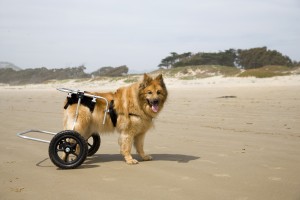Hip Dysplasia in Dogs - What is it?
 Hip dysplasia is a malformation of the hip socket (acetabulum) and the femoral head (thigh bone) causing a loose joint to form allowing for excessive "sloppy" movement in the joint. This excessive "sloppy" movement causes changes in the acetabulum resulting in a broadening of the socket and a flattening of the femoral head. It has congenital, conformational and environmental factors and is found in many breeds of dogs and rarely humans.
Hip dysplasia is a malformation of the hip socket (acetabulum) and the femoral head (thigh bone) causing a loose joint to form allowing for excessive "sloppy" movement in the joint. This excessive "sloppy" movement causes changes in the acetabulum resulting in a broadening of the socket and a flattening of the femoral head. It has congenital, conformational and environmental factors and is found in many breeds of dogs and rarely humans.
The severity varies greatly but can develop quite painful lameness and arthritis (inflammation of the joints). Many large breed dogs suffer from Hip Dysplasia as well as other knee injuries.
Hip Dysplasia in Dogs - Evaluating the condition.
The balance of the muscles of the hips have a large impact on the formation and progression of this disease. This condition can be evaluated by 18-24 months by radiographs, but these generally must be accompanied by sedation for proper positioning.
Evaluation for gait and stride changes that can spot early indications can be done throughout the first two years by veterinarians or trainers with this special interest training.
Hip Dysplasia in Dogs - Treatment
Gentle massage, "chiropractic" spinal adjustments, acupuncture and "gold Bead" implanted acupuncture can possibly prevent or diminish the formation of this condition in some pets, and can correct some of the imbalances and greatly reduce the pain and discomfort for the pet once symptoms develop.
Supplemental nutrition to reduce muscle inflammation and to rebuild cartilage is always beneficial once symptoms begin.
Keeping weight down to decrease additional stress on the joints and reducing stress and impact activities to decrease impact of the joints both during the formative first two years and once any symptoms develop is also beneficial.
Anti-inflammatory and pain medications may be needed as the condition progresses, but herbal supplements and homeopathic remedies can reduce the need and dosage of these medications necessary for relief.
Surgical intervention in severe cases can be helpful in some pets. Pelvic techniques to correct the imbalance on the joints or total hip replacements are two possible surgical interventions. Femoral Head Osteotomy (FHO) is a salvage procedure used in some smaller breeds.
Exercises to counterbalance the muscles greatly help prevent the development during these years as well as improves the overall condition of the pet later throughout life.
Many large breed dogs suffer from Hip Dysplasia as well as other knee injuries.
Read additional articles by Dr. Trish below:
- Choosing a breed of dog or cat
- Nutrition
- Supplements
- Probiotics
- General care
- Choice of veterinary care
- Treatment choices
- Vaccines and Titers
Dr. Trish Kallenbach DVM, CVCP has been providing exceptional holistic veterinary care for nearly two decades, continually expanding her training and treatment knowledge. She is an active member of AVMA, AHVMA, and FVMA.

